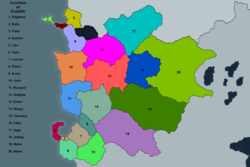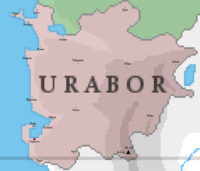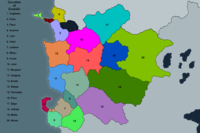Difference between revisions of "Urabor"
m (→Government) |
m (→Government) |
||
| Line 134: | Line 134: | ||
===Government=== | ===Government=== | ||
Urabor as it stands today is ruled under a semi-constitutional monarchy headed by The Queen and Oracle of ''Ɉolbaɉiġa Bärmey Karmen'' of the ''Jäçar'' clan and her Sister Archduchess and Speaker, ''Daiġa Þȁlǩov Jäçar''. | Urabor as it stands today is ruled under a semi-constitutional monarchy headed by The Queen and Oracle of ''Ɉolbaɉiġa Bärmey Karmen'' of the ''Jäçar'' clan and her Sister Archduchess and Speaker, ''Daiġa Þȁlǩov Jäçar''. Whose family has been the monarchs since 1106 KÜ and subsequent establishment of the ''Jäçar'' dynasty by King ''Ġaɉar Üdgän Jäçar'', great-great-grandson of the prophet ''Sðälp''. And records official dates as such giving Urabor three different calendars. KÜ ({{cs|AEH|KLVA ÜRABȌȌR}} ''Klva Ürabȍȍr'' [[Aldahnten|[klva ʏrabʊːr]]]), KĠ ({{cs|AEH|KLVA ĠAɈAR}} ''Klva Ġaɉar'' [[Aldahnten|[klva ɣadʲar]]]) and standard. Being 1928 KÜ, 789 KĠ, and 2021 respectively, at time of writing. | ||
===Administrative divisions=== | ===Administrative divisions=== | ||
Revision as of 17:03, 31 October 2021
| The Kingdom of Urabor Qlau Hn Ürabȍȍr QLAU HN ÜRABȌȌR |
||||||
|---|---|---|---|---|---|---|
|
||||||
| Motto: "Ɉoləhan Gaǩarokava Ïluhäġaltr" ɈOLƏHAN GAǨAROKAVA ÏLUHÄĠALTR "God's mighty fist" |
||||||
| Anthem: "Ɉoləhan Gahont Sä Loǩarokava" ɈOLƏHAN GAHONT SÄ LOǨAROKAVA "Lord give her strength" |
||||||
Counties of Urabor
|
||||||
| Capital and largest city | Üdgänen | |||||
| Official languages | Aldahnten | |||||
| Recognised national languages | Kavrinian Setyalnian |
|||||
| Recognised regional languages | Nuhzäyin Münida |
|||||
| Ethnic groups | 61.5% Kav 30.7% Human 7.78% Fals 0.02% Dalar |
|||||
| Demonym | Ürabȍȍrħen ÜRABȌȌRĦEN Uraborian |
|||||
| Government | semi-constitutional monarchy | |||||
| - | Ɉal ɈAL Queen |
Bärmey Jäçar BÄRMEY JÄÇAR |
||||
| - | Ɉalħen ɈALĦEN Archduchess |
Daiġa Jäçar DAIĠA JÄÇAR |
||||
| Legislature | Klinɉalsheük KLINɈALSHEÜK |
|||||
| - | Upper house | Klinɉalsiðogd KLINɈALSIÐOGD |
||||
| - | Lower house | Mucithnsheük MUCITHNSHEÜK |
||||
| Establishment | ||||||
| - | The Orenahn tribes arrive at the Ðravəna bay and modern day Üdgänen, marking the start of the Orenahnian Cheifdoms and day of ancestors | ~ 2750 ǨÜ (~2657 BCE) | ||||
| - | The War of Dominance and establishment of the Lömeqű empire along the coast of modern day Ürabȍȍr and the day of Prevailing | ~ 1370 ǨÜ (~1277 BCE) | ||||
| - | The Ralmï coup and establishment of the Fascist state of Ralmïanï, marking the day of Judgment | 263 ǨÜ (170 BCE) | ||||
| - | The War of Freedom and establishment of the Kav republic of Neshim, marking the day of Praise | 179 ǨÜ (86 BCE) | ||||
| - | The War of Iindependence and establishment of the Kingdom of Ürabȍȍr, marking the day of Freedom | 0 KÜ (93 CE) | ||||
| - | The beginning of the Ɉolbaɉiġa genocide and marking the day of mourning | 773 KÜ (866) | ||||
| - | Beginning of the Jäçar Dynasty, coronation of King Ġaɉar Üdgän Jäçar and marking the day of God | 1106 KÜ (1199) | ||||
| - | Unification into the Grand Alliance Confederation | 1636 KÜ (1729) | ||||
| - | Establishment of current borders of The Kingdom of Ürabȍȍr after the fall of the Setyal Empire and marking the day of Unification | 1751 KÜ (1844) | ||||
| Area | ||||||
| - | 397,638 km2 153,529 sq mi |
|||||
| Population | ||||||
| - | 2020 census | 35,507,857 | ||||
| - | Density | 34/km2 88.1/sq mi |
||||
| GDP (nominal) | estimate | |||||
| - | Total | $400.36 Billion | ||||
| - | Per capita | $11,246 | ||||
| Gini | 38 medium |
|||||
| HDI | 0.63 medium |
|||||
| Currency | Ȝülaħa (UYH) | |||||
| Time zone | (SCT-5) | |||||
| Date format | dd-mm-yyyy KÜ dd-mm-yyyy KĠ dd-mm-yyyy |
|||||
| Drives on the | right | |||||
| Calling code | +392 | |||||
| Internet TLD | .ur | |||||
Urabor (Aldahnten: QLAU HN ÜRABȌȌR Qlau Hn Ürabȍȍr [qlau hn ʏrabʊːr]), officially the The Kingdom Of Urabor, is a country located in western Upper Boroso. Urabor is bordered by Lhavres to the north and the Czucz sea to the west. Urabor is divided by population into 20 administrative counties. Geografically, Urabor has a mountainous interior and costal semi-arid deserts and a small savanah around the Ðravəna bay (Aldahnten: ÐRAVƏNA KȀLO Ðravəna Kȁlo [ðravʔna kælɔ]). Urabor is traditionally a matriarchal society, pushing its women to the forefront of all discussions and decisions.
Etymology
The name Ürabȍȍr (ÜRABȌȌR) is derived from the word Üra (ÜRA) [ʏra] meaning desert and the word Bȍȍr (BȌȌR) [bʊːr] meaning tribe, as the current Kingdom was established by the desert tribe lead by Naəv Twvanï (NAƏV TWVANÏ) [naʔv twvani].
History
Geography
Geology
The Highest point in Urabor is Mt. Ɉol (Aldahnten: MYONMYANA ɈOL Myonmyana Ɉol [mʲɔnmʲana dʲɔl]) at 3,754 meters (12,316 feet).
Climate
The majority of Urabor is a Hot Semi-Arid desert whilst the counties of Flant and Neshim are classified as a Tropical Wet and Dry Savanah.
Biodiversity
Politics
Government
Urabor as it stands today is ruled under a semi-constitutional monarchy headed by The Queen and Oracle of Ɉolbaɉiġa Bärmey Karmen of the Jäçar clan and her Sister Archduchess and Speaker, Daiġa Þȁlǩov Jäçar. Whose family has been the monarchs since 1106 KÜ and subsequent establishment of the Jäçar dynasty by King Ġaɉar Üdgän Jäçar, great-great-grandson of the prophet Sðälp. And records official dates as such giving Urabor three different calendars. KÜ (KLVA ÜRABȌȌR Klva Ürabȍȍr [klva ʏrabʊːr]), KĠ (KLVA ĠAɈAR Klva Ġaɉar [klva ɣadʲar]) and standard. Being 1928 KÜ, 789 KĠ, and 2021 respectively, at time of writing.
Administrative divisions
Urabor is split into 20 Counties, each named after their respective capital. All counties are sized by their respective populations with larger populations being in smaller counties and smaller populations in larger counties to accommodate respective businesses and distribution of wealth
Foreign relations
Currently Urabor has trading relations with Cananganam, trading natron and sand, for food products and manufacturered goods. In turn the propagation of Lunukisisu in the northern counties of Urabor has been slowly integrated into local traditions and religion of Ɉolbaɉiġa.Though Cananganam has had a presence within Urabor for centuries now, with its missions, only with the Establishment of the Jäçar dynasty in 1106 KÜ has Urabor recognized its state religion and the legitimacy of its missions within the Kingdom.
Military
Urabor requires a 6 year minimum military conscription beginning at age 20 for men and an 8 year minimum conscription beginning at age 18 for women. Any military service afterwards is paid and rewarded greatly.
Urabor holds a standing army of 1,500,000 at times of peace and increases its army to 5,000,000 at times of war. Any attempt to dodge conscription or draft, outside of medical reasons, is a punishable offense of at minimum 5 years in prison and a 150,000 Ȝülaħa fine.
Though Urabor is sympathetic to immigrants, and willing to accept them, any immigrants wanting citizenship under the age of 26 must enter military service for a minimum of 2 years. Whilst long-term non-citizen immigrants must enter military service for a minimum of 2 years, if they are under the age of 30. Whilst their children must enter military service for a minimum of 4 years at age 22 regardless of gender.
Military service in Urabor is seen as a great honor and is a prime reason a 6 year minimum service is a requirement for full citizenship, given the parents of said citizen are also full citizens.
Economy
Transport
The majority of Uraborians travel by train, though the recent[1] construction of the Trans-Üra freeway has opened up a growing Automotive industry within the country. Trains do still dominate the transportation sector holding nearly 85% of all economic traffic within the Kingdom.
Energy
The Majority of the energy within the country are produced via means of coal and Natural gas, with a small sector of solar
Science and technology
Tourism
Urabor is relatively new into the Tourism industry, seeing it mostly as large source of income. During the early 1960's the country formal opened up to tourism after the abolition of human slavery in 1943. All monarchs after 1964 have sought to build the tourism sector and fund large restoration and construction projects in a bid to make the country seem more appealing to tourists.
Demographics
Species
While Urabor remains a country of many peoples. The majority of the population is made up of Kavs with a making up 61.5% of the population as of the 2020 census. The population by species is as follows:
Ethnic groups
Uraborians rarely identify by ethnic group, usually sticking to the ways of their ancestors and abiding by tribal affiliation, the largest of which being the Üdgän and Nesh tribes, who speak Aldahnten and Jasian respectfully
Urbanisation
The Majority of Urabor is sparsely populated, with almost the entire population located in one of six counties: Üdgänen, Flant, Neshim, Ǩaǩo and Őhlan respectfully, in descending order of population[2].
Language
The official language of the Kingdom is Aldahnten, with its use dominating the political and education spheres. Though many other Orenahnian languages are spoken colloquially in the various counties and city districts of Urabor. They also recognize Kavrinian and Setyalnian on the national level, but is to be noted that their use is rarely used in any official documents or news networks.
Education
Education within Urabor is by law a requirement until the age of 16 for both males and females of any species. whilst higher education is highly promoted after military service and in many cases is subsidized by the Uraborian government. Uraborians tend to be a proud people regarding education, boasting a near 100% literacy rating[3], though the data shows a literacy rate closer to around 65%[4]
Healthcare
Most citizens on the coasts within the Kingdom recieve either partially or fully government sponsored healthcare, while the interior suffers from a lack of available doctors or government agencies and hospitals.
While the government boasts about the open healthcare enrollment, and high numbers of participation, the reality is much more grim, with the truth being closer to low enrollment outside of the upper echelons of Uraborian society.
Religion
The subject of religion in Urabor is inimical at best with regards to any other faith outside of the national doctrine of Ɉolbaɉiġa or the minority religion of Lunukisisu in the north[5]
Culture
Heritage
Architecture
Though the architecture of Uraborian society is diverse, most homes and legislation building top out at 2 stories and are made up of sandstone and quarried stone, with sporadic use of adobe and wood in Northern counties, particularly by the coast. Interior cities such as Meħa and Afuən provide most of the stone used in construction throughout Urabor, whilst central towns such as ȝaga provide most of the sandstone for the nation. Flant and Neshim provide all adobe and wood construction materials, shipping only down the coast.
The largest structures within Urabor consist of the Grand ġaɉarï citadel, being built nearly entirely of red granite and Marble. And various temples built using marble, granite, Limestone and sandstone.
Literature
Art
Music
Theatre
Film
Cuisine
Sport
Symbols
See also
- ↑ 1998.
- ↑ County sizes are inversely proportional to population size.
- ↑ This is a hotly debated statistic
- ↑ independent surveys, of which said surveyors may have been arrested
- ↑ Lunukisisu is tolerated and even borrowed from, mostly in part to the ongoing trade relations of Cananganam and historical presence in the region.




